Psychological Discontinuities in Transition to Primary Schools
VerifiedAdded on 2021/04/21
|15
|4541
|143
Essay
AI Summary
This essay examines the multifaceted challenges children face when transitioning from preschool to primary school, particularly within the Singaporean context. It explores the concept of school readiness and the importance of a smooth transition for children's academic and social development. The essay delves into three key psychological discontinuities: physical, social, and philosophical. Physical discontinuity addresses the differences in school environments, including building design and spatial organization, and their potential impact on children's emotional well-being. Social discontinuity focuses on the changes in relationships and interactions with peers and adults, highlighting the stress of forming new social connections. Philosophical discontinuity contrasts the play-based learning in preschools with the more academic-focused approach of primary schools. The essay emphasizes the need for understanding these discontinuities to support children effectively during this crucial period. The essay uses research to highlight the importance of the issue.
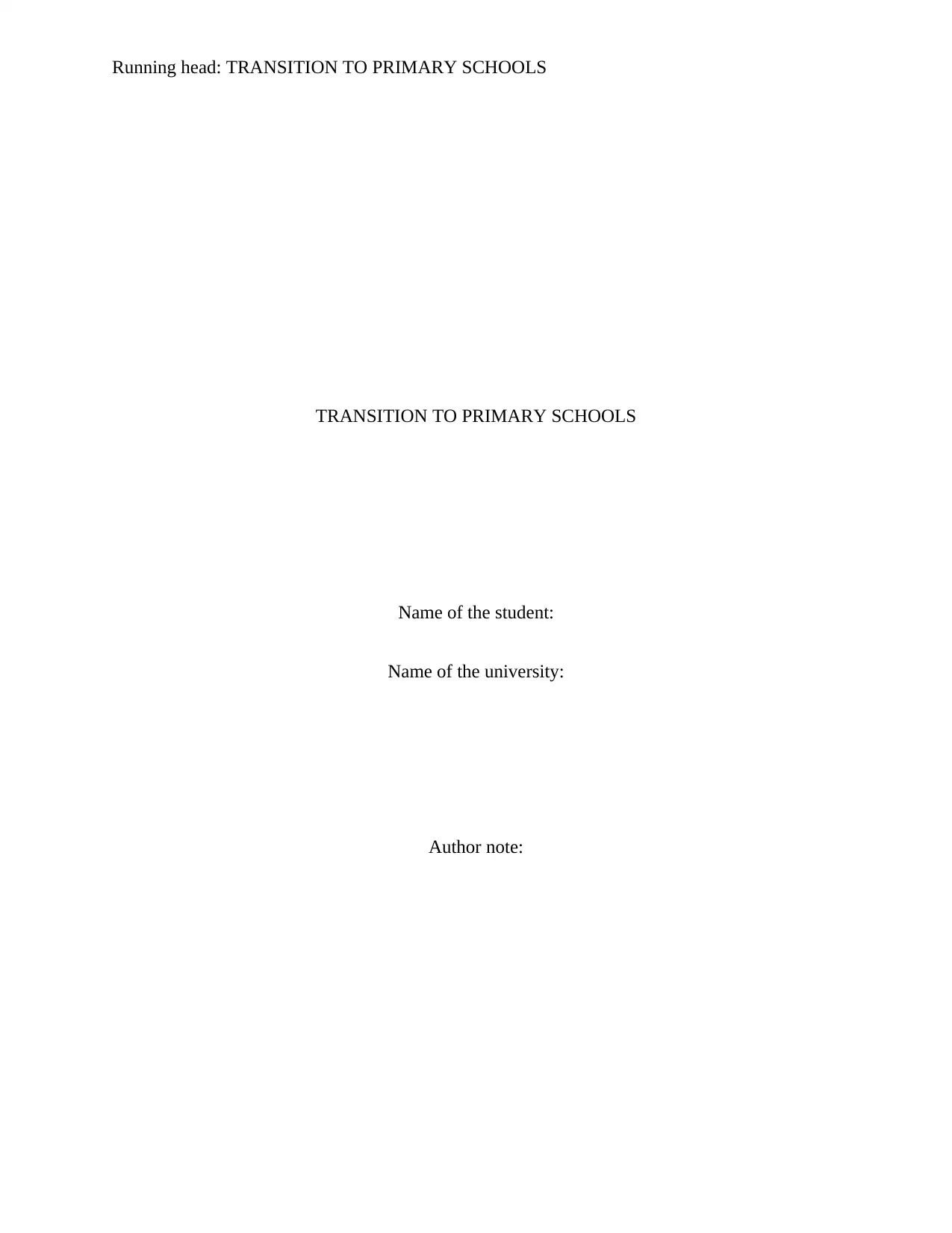
Running head: TRANSITION TO PRIMARY SCHOOLS
TRANSITION TO PRIMARY SCHOOLS
Name of the student:
Name of the university:
Author note:
TRANSITION TO PRIMARY SCHOOLS
Name of the student:
Name of the university:
Author note:
Paraphrase This Document
Need a fresh take? Get an instant paraphrase of this document with our AI Paraphraser

1
TRANSITION TO PRIMARY SCHOOLS
Introduction: (Question 1)
Transitions in schools are considered as those transformations which students go through
as they are promoted to different schools as different stages of the lives. These transitions are
seen to play an important role in the moral and cognitive development of the students where they
learn moral reasoning, decision making and participating in social activities with gradual
development of academic knowledge and learning of soft skills (Yeo & Clarke, 2006). In the
present generation, huge numbers of researchers are working on different aspects of successful
transitions to schools and are providing valuable information about the different aspects. They
are of the opinion that successful transitions have very positive impacts on the academic and
social performance in the first year of the school and in the later years of schooling also. They
are also of the opinion that children who undergo smooth transition can easily attain early
success in schools and therefore tend to maintain a higher level of social competence as well as
academic achievement (Crossnoe, Benner & David-Kean, 2016). Researchers have found that
successful transitions has definite links to that of the readiness of schools and such successful
transitions can only be achieved when the children can emotionally, intellectually, physically as
well as psychologically able to settle in the primary school. However, researchers have now paid
more importance to the relational nature of the concept of school readiness that involves the
readiness of the schools to accept the children and the children’s readiness to visit the schools
(Costales & Anderson, 2018). The National Education Goals Panel (NEGP) has successfully
helped in developing a definition of school readiness that comprised of their important factors.
The first one is the “readiness of schools” that involves the schools’ need to be ready to accept
children from a wide variety of backgrounds, needs, cultures and abilities. The second
component is readiness of the children (what knowledge the children have and what they can
TRANSITION TO PRIMARY SCHOOLS
Introduction: (Question 1)
Transitions in schools are considered as those transformations which students go through
as they are promoted to different schools as different stages of the lives. These transitions are
seen to play an important role in the moral and cognitive development of the students where they
learn moral reasoning, decision making and participating in social activities with gradual
development of academic knowledge and learning of soft skills (Yeo & Clarke, 2006). In the
present generation, huge numbers of researchers are working on different aspects of successful
transitions to schools and are providing valuable information about the different aspects. They
are of the opinion that successful transitions have very positive impacts on the academic and
social performance in the first year of the school and in the later years of schooling also. They
are also of the opinion that children who undergo smooth transition can easily attain early
success in schools and therefore tend to maintain a higher level of social competence as well as
academic achievement (Crossnoe, Benner & David-Kean, 2016). Researchers have found that
successful transitions has definite links to that of the readiness of schools and such successful
transitions can only be achieved when the children can emotionally, intellectually, physically as
well as psychologically able to settle in the primary school. However, researchers have now paid
more importance to the relational nature of the concept of school readiness that involves the
readiness of the schools to accept the children and the children’s readiness to visit the schools
(Costales & Anderson, 2018). The National Education Goals Panel (NEGP) has successfully
helped in developing a definition of school readiness that comprised of their important factors.
The first one is the “readiness of schools” that involves the schools’ need to be ready to accept
children from a wide variety of backgrounds, needs, cultures and abilities. The second
component is readiness of the children (what knowledge the children have and what they can
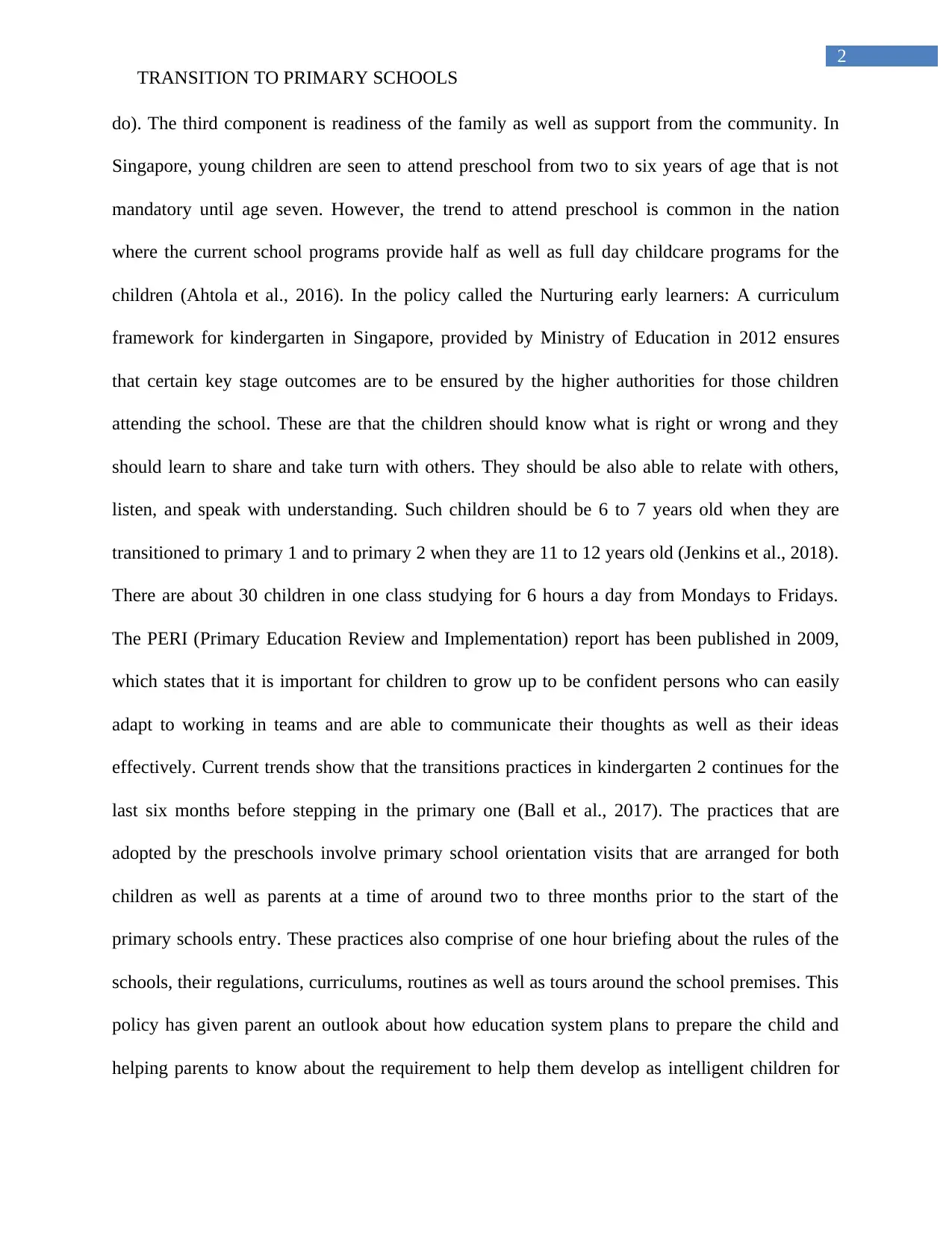
2
TRANSITION TO PRIMARY SCHOOLS
do). The third component is readiness of the family as well as support from the community. In
Singapore, young children are seen to attend preschool from two to six years of age that is not
mandatory until age seven. However, the trend to attend preschool is common in the nation
where the current school programs provide half as well as full day childcare programs for the
children (Ahtola et al., 2016). In the policy called the Nurturing early learners: A curriculum
framework for kindergarten in Singapore, provided by Ministry of Education in 2012 ensures
that certain key stage outcomes are to be ensured by the higher authorities for those children
attending the school. These are that the children should know what is right or wrong and they
should learn to share and take turn with others. They should be also able to relate with others,
listen, and speak with understanding. Such children should be 6 to 7 years old when they are
transitioned to primary 1 and to primary 2 when they are 11 to 12 years old (Jenkins et al., 2018).
There are about 30 children in one class studying for 6 hours a day from Mondays to Fridays.
The PERI (Primary Education Review and Implementation) report has been published in 2009,
which states that it is important for children to grow up to be confident persons who can easily
adapt to working in teams and are able to communicate their thoughts as well as their ideas
effectively. Current trends show that the transitions practices in kindergarten 2 continues for the
last six months before stepping in the primary one (Ball et al., 2017). The practices that are
adopted by the preschools involve primary school orientation visits that are arranged for both
children as well as parents at a time of around two to three months prior to the start of the
primary schools entry. These practices also comprise of one hour briefing about the rules of the
schools, their regulations, curriculums, routines as well as tours around the school premises. This
policy has given parent an outlook about how education system plans to prepare the child and
helping parents to know about the requirement to help them develop as intelligent children for
TRANSITION TO PRIMARY SCHOOLS
do). The third component is readiness of the family as well as support from the community. In
Singapore, young children are seen to attend preschool from two to six years of age that is not
mandatory until age seven. However, the trend to attend preschool is common in the nation
where the current school programs provide half as well as full day childcare programs for the
children (Ahtola et al., 2016). In the policy called the Nurturing early learners: A curriculum
framework for kindergarten in Singapore, provided by Ministry of Education in 2012 ensures
that certain key stage outcomes are to be ensured by the higher authorities for those children
attending the school. These are that the children should know what is right or wrong and they
should learn to share and take turn with others. They should be also able to relate with others,
listen, and speak with understanding. Such children should be 6 to 7 years old when they are
transitioned to primary 1 and to primary 2 when they are 11 to 12 years old (Jenkins et al., 2018).
There are about 30 children in one class studying for 6 hours a day from Mondays to Fridays.
The PERI (Primary Education Review and Implementation) report has been published in 2009,
which states that it is important for children to grow up to be confident persons who can easily
adapt to working in teams and are able to communicate their thoughts as well as their ideas
effectively. Current trends show that the transitions practices in kindergarten 2 continues for the
last six months before stepping in the primary one (Ball et al., 2017). The practices that are
adopted by the preschools involve primary school orientation visits that are arranged for both
children as well as parents at a time of around two to three months prior to the start of the
primary schools entry. These practices also comprise of one hour briefing about the rules of the
schools, their regulations, curriculums, routines as well as tours around the school premises. This
policy has given parent an outlook about how education system plans to prepare the child and
helping parents to know about the requirement to help them develop as intelligent children for
⊘ This is a preview!⊘
Do you want full access?
Subscribe today to unlock all pages.

Trusted by 1+ million students worldwide

3
TRANSITION TO PRIMARY SCHOOLS
the future (Walker et al., 2016). Kindergarten Curriculum Framework therefore provides a wide
discussion to the parents.
Question 2:
Physical discontinuity:
Children who are stepping into primary schools after completing their years in the
preschools need to be guided properly as they go through numerous unpredictable psychological
changes during these transitions. Researchers have defined physical discontinuity as the break
that students experience between the old arena of the preschools as well as the entry into the new
as well as untreated ground. This can be energizing and inspiring for the children but on the other
hand, it may also case fear of the unknown and extreme dislike growing from emotional turmoil
of living a known place and visiting an unknown place for studying (Choy et al., 2016).
Researchers are of the opinion that organization of time and space is indeed an important aspect
of work and life both in primary schools as well as preschools. The arrangement done regarding
to space, time organizing activities as well as physical environment are seen to significantly
impact on the quality of life for both the children as well as the adults. The general atmosphere
determines the organization of time and space where the educational works are placed in the
educational institutions (Sigurroardotrir, 2018). Spatial organizations in preschools are quite
different from that of the primary schools in terms of interiors designing of the physical learning
environment. Feelings of insecurity as well as maladjustment are noted in cases of the children
who go through this transition and these maladjustments mainly come from the differences
between objects, interiors as well as exteriors that exist between preschool and primary schools.
The children who are coming from the kindergarten schools are used to the layout as well as the
TRANSITION TO PRIMARY SCHOOLS
the future (Walker et al., 2016). Kindergarten Curriculum Framework therefore provides a wide
discussion to the parents.
Question 2:
Physical discontinuity:
Children who are stepping into primary schools after completing their years in the
preschools need to be guided properly as they go through numerous unpredictable psychological
changes during these transitions. Researchers have defined physical discontinuity as the break
that students experience between the old arena of the preschools as well as the entry into the new
as well as untreated ground. This can be energizing and inspiring for the children but on the other
hand, it may also case fear of the unknown and extreme dislike growing from emotional turmoil
of living a known place and visiting an unknown place for studying (Choy et al., 2016).
Researchers are of the opinion that organization of time and space is indeed an important aspect
of work and life both in primary schools as well as preschools. The arrangement done regarding
to space, time organizing activities as well as physical environment are seen to significantly
impact on the quality of life for both the children as well as the adults. The general atmosphere
determines the organization of time and space where the educational works are placed in the
educational institutions (Sigurroardotrir, 2018). Spatial organizations in preschools are quite
different from that of the primary schools in terms of interiors designing of the physical learning
environment. Feelings of insecurity as well as maladjustment are noted in cases of the children
who go through this transition and these maladjustments mainly come from the differences
between objects, interiors as well as exteriors that exist between preschool and primary schools.
The children who are coming from the kindergarten schools are used to the layout as well as the
Paraphrase This Document
Need a fresh take? Get an instant paraphrase of this document with our AI Paraphraser
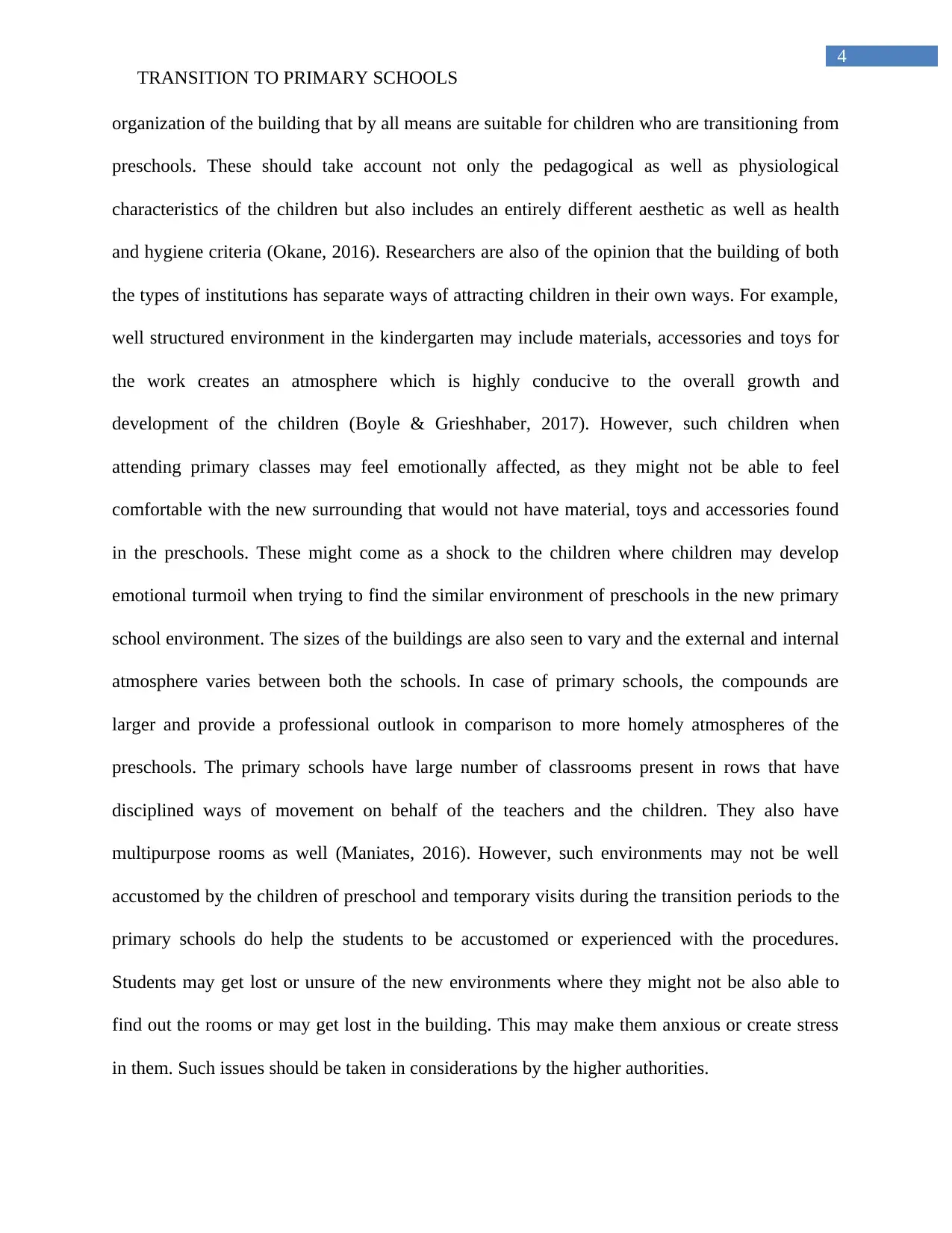
4
TRANSITION TO PRIMARY SCHOOLS
organization of the building that by all means are suitable for children who are transitioning from
preschools. These should take account not only the pedagogical as well as physiological
characteristics of the children but also includes an entirely different aesthetic as well as health
and hygiene criteria (Okane, 2016). Researchers are also of the opinion that the building of both
the types of institutions has separate ways of attracting children in their own ways. For example,
well structured environment in the kindergarten may include materials, accessories and toys for
the work creates an atmosphere which is highly conducive to the overall growth and
development of the children (Boyle & Grieshhaber, 2017). However, such children when
attending primary classes may feel emotionally affected, as they might not be able to feel
comfortable with the new surrounding that would not have material, toys and accessories found
in the preschools. These might come as a shock to the children where children may develop
emotional turmoil when trying to find the similar environment of preschools in the new primary
school environment. The sizes of the buildings are also seen to vary and the external and internal
atmosphere varies between both the schools. In case of primary schools, the compounds are
larger and provide a professional outlook in comparison to more homely atmospheres of the
preschools. The primary schools have large number of classrooms present in rows that have
disciplined ways of movement on behalf of the teachers and the children. They also have
multipurpose rooms as well (Maniates, 2016). However, such environments may not be well
accustomed by the children of preschool and temporary visits during the transition periods to the
primary schools do help the students to be accustomed or experienced with the procedures.
Students may get lost or unsure of the new environments where they might not be also able to
find out the rooms or may get lost in the building. This may make them anxious or create stress
in them. Such issues should be taken in considerations by the higher authorities.
TRANSITION TO PRIMARY SCHOOLS
organization of the building that by all means are suitable for children who are transitioning from
preschools. These should take account not only the pedagogical as well as physiological
characteristics of the children but also includes an entirely different aesthetic as well as health
and hygiene criteria (Okane, 2016). Researchers are also of the opinion that the building of both
the types of institutions has separate ways of attracting children in their own ways. For example,
well structured environment in the kindergarten may include materials, accessories and toys for
the work creates an atmosphere which is highly conducive to the overall growth and
development of the children (Boyle & Grieshhaber, 2017). However, such children when
attending primary classes may feel emotionally affected, as they might not be able to feel
comfortable with the new surrounding that would not have material, toys and accessories found
in the preschools. These might come as a shock to the children where children may develop
emotional turmoil when trying to find the similar environment of preschools in the new primary
school environment. The sizes of the buildings are also seen to vary and the external and internal
atmosphere varies between both the schools. In case of primary schools, the compounds are
larger and provide a professional outlook in comparison to more homely atmospheres of the
preschools. The primary schools have large number of classrooms present in rows that have
disciplined ways of movement on behalf of the teachers and the children. They also have
multipurpose rooms as well (Maniates, 2016). However, such environments may not be well
accustomed by the children of preschool and temporary visits during the transition periods to the
primary schools do help the students to be accustomed or experienced with the procedures.
Students may get lost or unsure of the new environments where they might not be also able to
find out the rooms or may get lost in the building. This may make them anxious or create stress
in them. Such issues should be taken in considerations by the higher authorities.
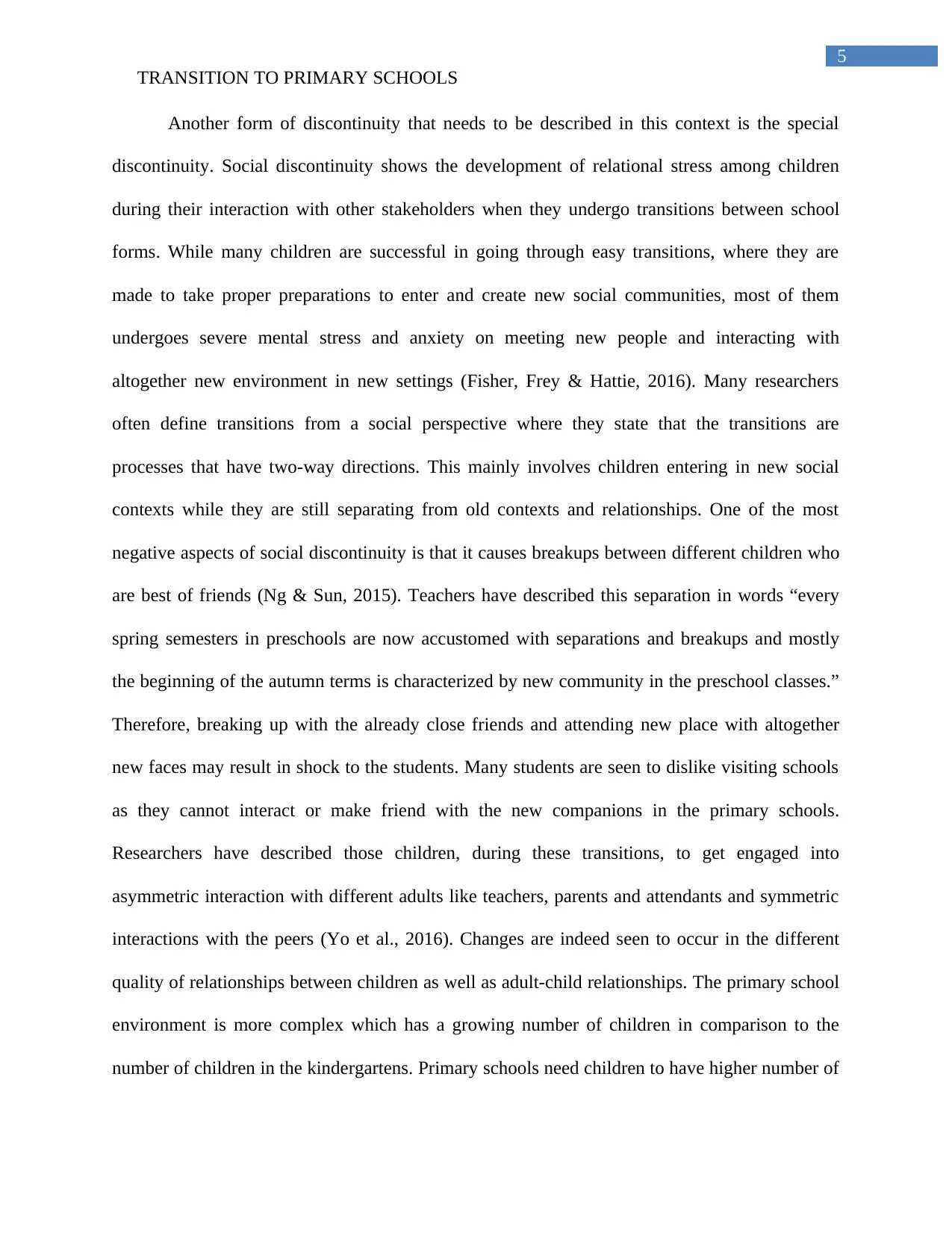
5
TRANSITION TO PRIMARY SCHOOLS
Another form of discontinuity that needs to be described in this context is the special
discontinuity. Social discontinuity shows the development of relational stress among children
during their interaction with other stakeholders when they undergo transitions between school
forms. While many children are successful in going through easy transitions, where they are
made to take proper preparations to enter and create new social communities, most of them
undergoes severe mental stress and anxiety on meeting new people and interacting with
altogether new environment in new settings (Fisher, Frey & Hattie, 2016). Many researchers
often define transitions from a social perspective where they state that the transitions are
processes that have two-way directions. This mainly involves children entering in new social
contexts while they are still separating from old contexts and relationships. One of the most
negative aspects of social discontinuity is that it causes breakups between different children who
are best of friends (Ng & Sun, 2015). Teachers have described this separation in words “every
spring semesters in preschools are now accustomed with separations and breakups and mostly
the beginning of the autumn terms is characterized by new community in the preschool classes.”
Therefore, breaking up with the already close friends and attending new place with altogether
new faces may result in shock to the students. Many students are seen to dislike visiting schools
as they cannot interact or make friend with the new companions in the primary schools.
Researchers have described those children, during these transitions, to get engaged into
asymmetric interaction with different adults like teachers, parents and attendants and symmetric
interactions with the peers (Yo et al., 2016). Changes are indeed seen to occur in the different
quality of relationships between children as well as adult-child relationships. The primary school
environment is more complex which has a growing number of children in comparison to the
number of children in the kindergartens. Primary schools need children to have higher number of
TRANSITION TO PRIMARY SCHOOLS
Another form of discontinuity that needs to be described in this context is the special
discontinuity. Social discontinuity shows the development of relational stress among children
during their interaction with other stakeholders when they undergo transitions between school
forms. While many children are successful in going through easy transitions, where they are
made to take proper preparations to enter and create new social communities, most of them
undergoes severe mental stress and anxiety on meeting new people and interacting with
altogether new environment in new settings (Fisher, Frey & Hattie, 2016). Many researchers
often define transitions from a social perspective where they state that the transitions are
processes that have two-way directions. This mainly involves children entering in new social
contexts while they are still separating from old contexts and relationships. One of the most
negative aspects of social discontinuity is that it causes breakups between different children who
are best of friends (Ng & Sun, 2015). Teachers have described this separation in words “every
spring semesters in preschools are now accustomed with separations and breakups and mostly
the beginning of the autumn terms is characterized by new community in the preschool classes.”
Therefore, breaking up with the already close friends and attending new place with altogether
new faces may result in shock to the students. Many students are seen to dislike visiting schools
as they cannot interact or make friend with the new companions in the primary schools.
Researchers have described those children, during these transitions, to get engaged into
asymmetric interaction with different adults like teachers, parents and attendants and symmetric
interactions with the peers (Yo et al., 2016). Changes are indeed seen to occur in the different
quality of relationships between children as well as adult-child relationships. The primary school
environment is more complex which has a growing number of children in comparison to the
number of children in the kindergartens. Primary schools need children to have higher number of
⊘ This is a preview!⊘
Do you want full access?
Subscribe today to unlock all pages.

Trusted by 1+ million students worldwide
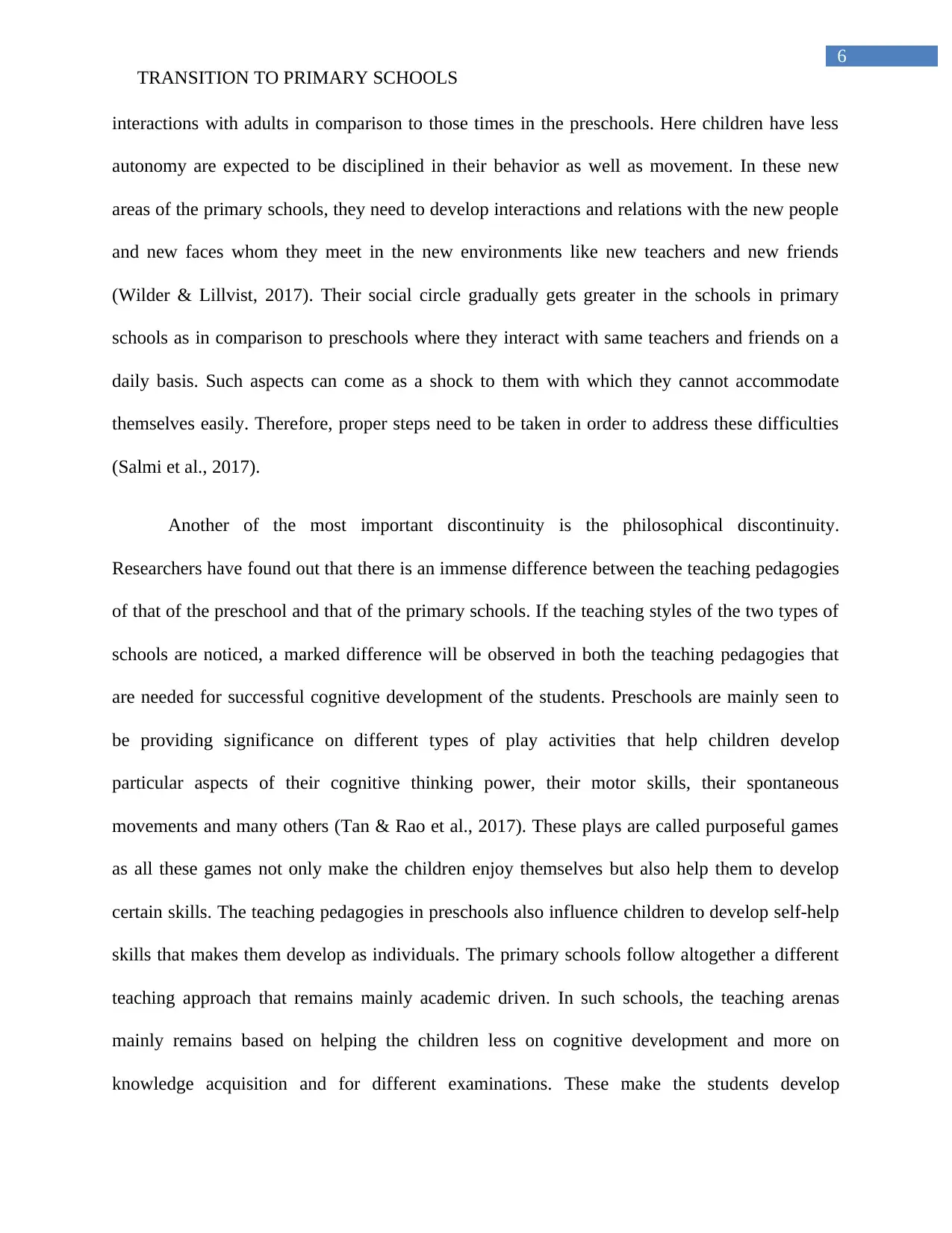
6
TRANSITION TO PRIMARY SCHOOLS
interactions with adults in comparison to those times in the preschools. Here children have less
autonomy are expected to be disciplined in their behavior as well as movement. In these new
areas of the primary schools, they need to develop interactions and relations with the new people
and new faces whom they meet in the new environments like new teachers and new friends
(Wilder & Lillvist, 2017). Their social circle gradually gets greater in the schools in primary
schools as in comparison to preschools where they interact with same teachers and friends on a
daily basis. Such aspects can come as a shock to them with which they cannot accommodate
themselves easily. Therefore, proper steps need to be taken in order to address these difficulties
(Salmi et al., 2017).
Another of the most important discontinuity is the philosophical discontinuity.
Researchers have found out that there is an immense difference between the teaching pedagogies
of that of the preschool and that of the primary schools. If the teaching styles of the two types of
schools are noticed, a marked difference will be observed in both the teaching pedagogies that
are needed for successful cognitive development of the students. Preschools are mainly seen to
be providing significance on different types of play activities that help children develop
particular aspects of their cognitive thinking power, their motor skills, their spontaneous
movements and many others (Tan & Rao et al., 2017). These plays are called purposeful games
as all these games not only make the children enjoy themselves but also help them to develop
certain skills. The teaching pedagogies in preschools also influence children to develop self-help
skills that makes them develop as individuals. The primary schools follow altogether a different
teaching approach that remains mainly academic driven. In such schools, the teaching arenas
mainly remains based on helping the children less on cognitive development and more on
knowledge acquisition and for different examinations. These make the students develop
TRANSITION TO PRIMARY SCHOOLS
interactions with adults in comparison to those times in the preschools. Here children have less
autonomy are expected to be disciplined in their behavior as well as movement. In these new
areas of the primary schools, they need to develop interactions and relations with the new people
and new faces whom they meet in the new environments like new teachers and new friends
(Wilder & Lillvist, 2017). Their social circle gradually gets greater in the schools in primary
schools as in comparison to preschools where they interact with same teachers and friends on a
daily basis. Such aspects can come as a shock to them with which they cannot accommodate
themselves easily. Therefore, proper steps need to be taken in order to address these difficulties
(Salmi et al., 2017).
Another of the most important discontinuity is the philosophical discontinuity.
Researchers have found out that there is an immense difference between the teaching pedagogies
of that of the preschool and that of the primary schools. If the teaching styles of the two types of
schools are noticed, a marked difference will be observed in both the teaching pedagogies that
are needed for successful cognitive development of the students. Preschools are mainly seen to
be providing significance on different types of play activities that help children develop
particular aspects of their cognitive thinking power, their motor skills, their spontaneous
movements and many others (Tan & Rao et al., 2017). These plays are called purposeful games
as all these games not only make the children enjoy themselves but also help them to develop
certain skills. The teaching pedagogies in preschools also influence children to develop self-help
skills that makes them develop as individuals. The primary schools follow altogether a different
teaching approach that remains mainly academic driven. In such schools, the teaching arenas
mainly remains based on helping the children less on cognitive development and more on
knowledge acquisition and for different examinations. These make the students develop
Paraphrase This Document
Need a fresh take? Get an instant paraphrase of this document with our AI Paraphraser
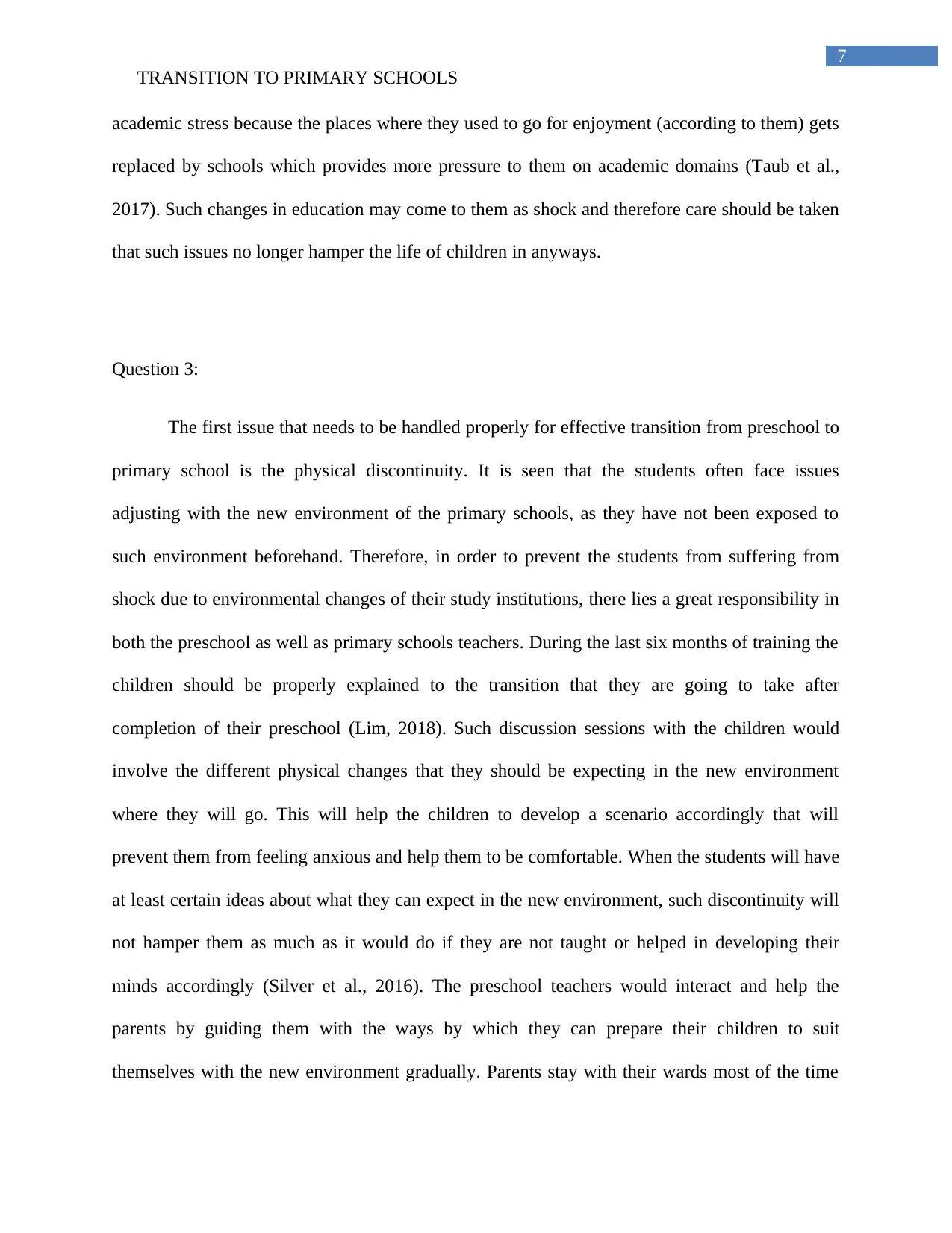
7
TRANSITION TO PRIMARY SCHOOLS
academic stress because the places where they used to go for enjoyment (according to them) gets
replaced by schools which provides more pressure to them on academic domains (Taub et al.,
2017). Such changes in education may come to them as shock and therefore care should be taken
that such issues no longer hamper the life of children in anyways.
Question 3:
The first issue that needs to be handled properly for effective transition from preschool to
primary school is the physical discontinuity. It is seen that the students often face issues
adjusting with the new environment of the primary schools, as they have not been exposed to
such environment beforehand. Therefore, in order to prevent the students from suffering from
shock due to environmental changes of their study institutions, there lies a great responsibility in
both the preschool as well as primary schools teachers. During the last six months of training the
children should be properly explained to the transition that they are going to take after
completion of their preschool (Lim, 2018). Such discussion sessions with the children would
involve the different physical changes that they should be expecting in the new environment
where they will go. This will help the children to develop a scenario accordingly that will
prevent them from feeling anxious and help them to be comfortable. When the students will have
at least certain ideas about what they can expect in the new environment, such discontinuity will
not hamper them as much as it would do if they are not taught or helped in developing their
minds accordingly (Silver et al., 2016). The preschool teachers would interact and help the
parents by guiding them with the ways by which they can prepare their children to suit
themselves with the new environment gradually. Parents stay with their wards most of the time
TRANSITION TO PRIMARY SCHOOLS
academic stress because the places where they used to go for enjoyment (according to them) gets
replaced by schools which provides more pressure to them on academic domains (Taub et al.,
2017). Such changes in education may come to them as shock and therefore care should be taken
that such issues no longer hamper the life of children in anyways.
Question 3:
The first issue that needs to be handled properly for effective transition from preschool to
primary school is the physical discontinuity. It is seen that the students often face issues
adjusting with the new environment of the primary schools, as they have not been exposed to
such environment beforehand. Therefore, in order to prevent the students from suffering from
shock due to environmental changes of their study institutions, there lies a great responsibility in
both the preschool as well as primary schools teachers. During the last six months of training the
children should be properly explained to the transition that they are going to take after
completion of their preschool (Lim, 2018). Such discussion sessions with the children would
involve the different physical changes that they should be expecting in the new environment
where they will go. This will help the children to develop a scenario accordingly that will
prevent them from feeling anxious and help them to be comfortable. When the students will have
at least certain ideas about what they can expect in the new environment, such discontinuity will
not hamper them as much as it would do if they are not taught or helped in developing their
minds accordingly (Silver et al., 2016). The preschool teachers would interact and help the
parents by guiding them with the ways by which they can prepare their children to suit
themselves with the new environment gradually. Parents stay with their wards most of the time

8
TRANSITION TO PRIMARY SCHOOLS
and when they will be helping the children, giving them proper ideas about what they can expect
and how they can keep themselves safe from losing their ways in the buildings, children would
be confident and would not develop anxiety. Moreover, only taking children to tours to such
primary schools is not sufficient, as only visiting classes will not help them develop proper ideas.
Rather children can be allowed to participate in 5 to 6 such sessions in primary schools to make
them habituated with the entire setting (Chai et al., 2016). Therefore, proper tours with 5 to 6
class sessions and proper responsibility taken by preschool teachers and parents to help students
develop an idea about what they would be expecting in primary schools would be helpful for
them.
The second issues which the students face is the social discontinuity. They often have to
develop new relationships with peers as well as teachers as the latter are new to them in the new
environment. In the preschools, the numbers of students are very few and they get well
accustomed to the limited number of students and teachers in the preschool. Therefore, when
they come to primary schools, they have to interact with huge number of students and teachers
that require proper social skills for them for effective relationship development. Therefore, it is
very important for the children to develop proper social skills by which they do not feel left out
or alone in the new environment (Nonis et al., 2016). With proper social skills, they will feel
confident and will not get scared on meeting a large number of people or staring interaction with
them. Proper social skills can be developed in the children that would ensure their overcoming
social discontinuities. They would never fear from expressing themselves that will help in
developing better environment for developing academic knowledge and free from stress and
pressure. One of the strategies, which the preschool teachers can start for 6 years olds are the
frame play where teachers and students can engage themselves in role-playing situations where
TRANSITION TO PRIMARY SCHOOLS
and when they will be helping the children, giving them proper ideas about what they can expect
and how they can keep themselves safe from losing their ways in the buildings, children would
be confident and would not develop anxiety. Moreover, only taking children to tours to such
primary schools is not sufficient, as only visiting classes will not help them develop proper ideas.
Rather children can be allowed to participate in 5 to 6 such sessions in primary schools to make
them habituated with the entire setting (Chai et al., 2016). Therefore, proper tours with 5 to 6
class sessions and proper responsibility taken by preschool teachers and parents to help students
develop an idea about what they would be expecting in primary schools would be helpful for
them.
The second issues which the students face is the social discontinuity. They often have to
develop new relationships with peers as well as teachers as the latter are new to them in the new
environment. In the preschools, the numbers of students are very few and they get well
accustomed to the limited number of students and teachers in the preschool. Therefore, when
they come to primary schools, they have to interact with huge number of students and teachers
that require proper social skills for them for effective relationship development. Therefore, it is
very important for the children to develop proper social skills by which they do not feel left out
or alone in the new environment (Nonis et al., 2016). With proper social skills, they will feel
confident and will not get scared on meeting a large number of people or staring interaction with
them. Proper social skills can be developed in the children that would ensure their overcoming
social discontinuities. They would never fear from expressing themselves that will help in
developing better environment for developing academic knowledge and free from stress and
pressure. One of the strategies, which the preschool teachers can start for 6 years olds are the
frame play where teachers and students can engage themselves in role-playing situations where
⊘ This is a preview!⊘
Do you want full access?
Subscribe today to unlock all pages.

Trusted by 1+ million students worldwide

9
TRANSITION TO PRIMARY SCHOOLS
roles are decided by the students and nurses and then a certain hypothetical situations is
conducted out in the form of drama. Through the help of a story, the teachers and students can
engage in structured conversations that are called literature dialogue. During all this dialogue
sharing, the teachers as well as the children have philosophical dialogues that reflect their
intentions as well as thoughts that are expressed in drawings and play activities. With such plays,
they can develop skills that help them to communicate effectively, solve different problems they
face and self help themselves without develop stress, fear and anxiety.
Another issue is the philosophical issue where the teaching pedagogy of the primary
schools varies a lot from the preschools. Therefore, it becomes difficult for the student to get
adapted to the new king of teaching ways that they did not follow for the seven years. The
teachings of the preschools include development of skills through purposeful plays which do not
follow a typical procedure as disciplined as the study procedure in the primary schools.
Teachings in primary schools are academic based approach where importance is given on
knowledge development rather than cognitive power development. Therefore, students should be
made accustomed to this form of learning and therefore the last months of the preschool period
should contain the teachers to initiate a teaching style that would help the students gradually get
accustomed to the style that they would be experiencing in the primary schools. The teachers
would gradually expose the students to different class scenarios that they would be going through
in the primary schools (Goff & Dockett, 2015). These would not make them feel new to the
environment of the new schools and therefore anxiety and depression from shocks will not take
place among the children.
Another issue that should be also considered is that the students do not remain aware of
what is expected from them in the new primary schools. They are not well accustomed to the
TRANSITION TO PRIMARY SCHOOLS
roles are decided by the students and nurses and then a certain hypothetical situations is
conducted out in the form of drama. Through the help of a story, the teachers and students can
engage in structured conversations that are called literature dialogue. During all this dialogue
sharing, the teachers as well as the children have philosophical dialogues that reflect their
intentions as well as thoughts that are expressed in drawings and play activities. With such plays,
they can develop skills that help them to communicate effectively, solve different problems they
face and self help themselves without develop stress, fear and anxiety.
Another issue is the philosophical issue where the teaching pedagogy of the primary
schools varies a lot from the preschools. Therefore, it becomes difficult for the student to get
adapted to the new king of teaching ways that they did not follow for the seven years. The
teachings of the preschools include development of skills through purposeful plays which do not
follow a typical procedure as disciplined as the study procedure in the primary schools.
Teachings in primary schools are academic based approach where importance is given on
knowledge development rather than cognitive power development. Therefore, students should be
made accustomed to this form of learning and therefore the last months of the preschool period
should contain the teachers to initiate a teaching style that would help the students gradually get
accustomed to the style that they would be experiencing in the primary schools. The teachers
would gradually expose the students to different class scenarios that they would be going through
in the primary schools (Goff & Dockett, 2015). These would not make them feel new to the
environment of the new schools and therefore anxiety and depression from shocks will not take
place among the children.
Another issue that should be also considered is that the students do not remain aware of
what is expected from them in the new primary schools. They are not well accustomed to the
Paraphrase This Document
Need a fresh take? Get an instant paraphrase of this document with our AI Paraphraser
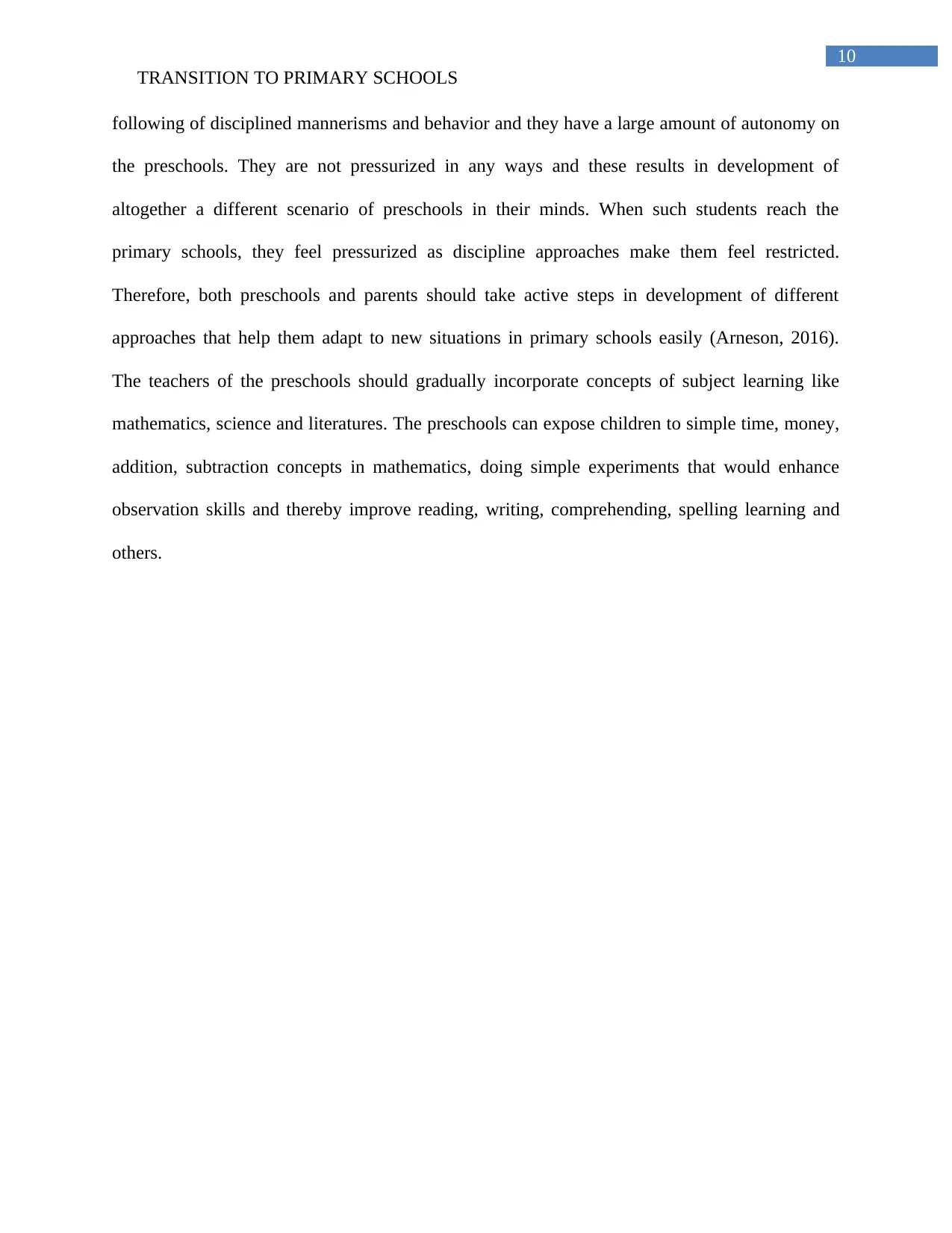
10
TRANSITION TO PRIMARY SCHOOLS
following of disciplined mannerisms and behavior and they have a large amount of autonomy on
the preschools. They are not pressurized in any ways and these results in development of
altogether a different scenario of preschools in their minds. When such students reach the
primary schools, they feel pressurized as discipline approaches make them feel restricted.
Therefore, both preschools and parents should take active steps in development of different
approaches that help them adapt to new situations in primary schools easily (Arneson, 2016).
The teachers of the preschools should gradually incorporate concepts of subject learning like
mathematics, science and literatures. The preschools can expose children to simple time, money,
addition, subtraction concepts in mathematics, doing simple experiments that would enhance
observation skills and thereby improve reading, writing, comprehending, spelling learning and
others.
TRANSITION TO PRIMARY SCHOOLS
following of disciplined mannerisms and behavior and they have a large amount of autonomy on
the preschools. They are not pressurized in any ways and these results in development of
altogether a different scenario of preschools in their minds. When such students reach the
primary schools, they feel pressurized as discipline approaches make them feel restricted.
Therefore, both preschools and parents should take active steps in development of different
approaches that help them adapt to new situations in primary schools easily (Arneson, 2016).
The teachers of the preschools should gradually incorporate concepts of subject learning like
mathematics, science and literatures. The preschools can expose children to simple time, money,
addition, subtraction concepts in mathematics, doing simple experiments that would enhance
observation skills and thereby improve reading, writing, comprehending, spelling learning and
others.
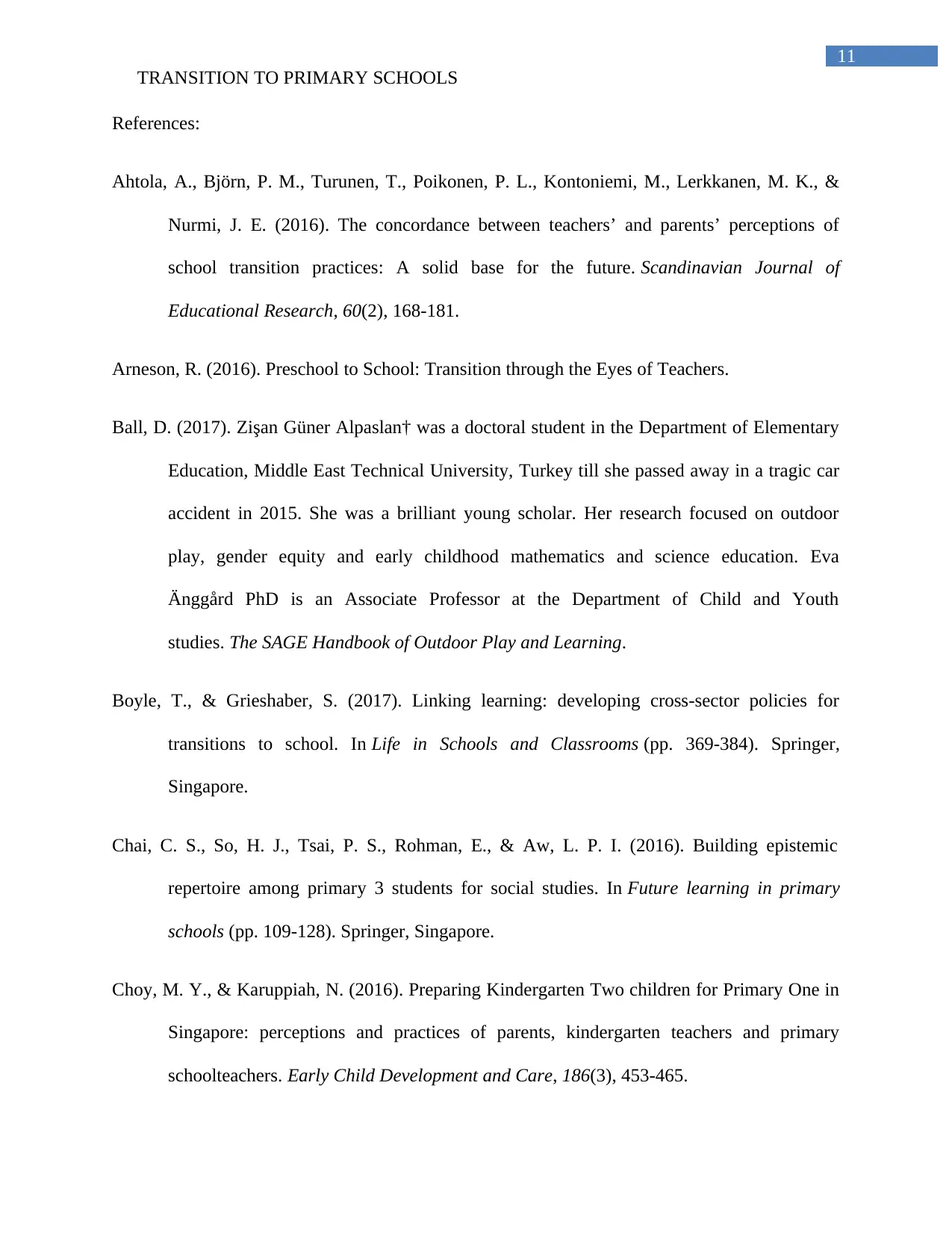
11
TRANSITION TO PRIMARY SCHOOLS
References:
Ahtola, A., Björn, P. M., Turunen, T., Poikonen, P. L., Kontoniemi, M., Lerkkanen, M. K., &
Nurmi, J. E. (2016). The concordance between teachers’ and parents’ perceptions of
school transition practices: A solid base for the future. Scandinavian Journal of
Educational Research, 60(2), 168-181.
Arneson, R. (2016). Preschool to School: Transition through the Eyes of Teachers.
Ball, D. (2017). Zişan Güner Alpaslan† was a doctoral student in the Department of Elementary
Education, Middle East Technical University, Turkey till she passed away in a tragic car
accident in 2015. She was a brilliant young scholar. Her research focused on outdoor
play, gender equity and early childhood mathematics and science education. Eva
Änggård PhD is an Associate Professor at the Department of Child and Youth
studies. The SAGE Handbook of Outdoor Play and Learning.
Boyle, T., & Grieshaber, S. (2017). Linking learning: developing cross-sector policies for
transitions to school. In Life in Schools and Classrooms (pp. 369-384). Springer,
Singapore.
Chai, C. S., So, H. J., Tsai, P. S., Rohman, E., & Aw, L. P. I. (2016). Building epistemic
repertoire among primary 3 students for social studies. In Future learning in primary
schools (pp. 109-128). Springer, Singapore.
Choy, M. Y., & Karuppiah, N. (2016). Preparing Kindergarten Two children for Primary One in
Singapore: perceptions and practices of parents, kindergarten teachers and primary
schoolteachers. Early Child Development and Care, 186(3), 453-465.
TRANSITION TO PRIMARY SCHOOLS
References:
Ahtola, A., Björn, P. M., Turunen, T., Poikonen, P. L., Kontoniemi, M., Lerkkanen, M. K., &
Nurmi, J. E. (2016). The concordance between teachers’ and parents’ perceptions of
school transition practices: A solid base for the future. Scandinavian Journal of
Educational Research, 60(2), 168-181.
Arneson, R. (2016). Preschool to School: Transition through the Eyes of Teachers.
Ball, D. (2017). Zişan Güner Alpaslan† was a doctoral student in the Department of Elementary
Education, Middle East Technical University, Turkey till she passed away in a tragic car
accident in 2015. She was a brilliant young scholar. Her research focused on outdoor
play, gender equity and early childhood mathematics and science education. Eva
Änggård PhD is an Associate Professor at the Department of Child and Youth
studies. The SAGE Handbook of Outdoor Play and Learning.
Boyle, T., & Grieshaber, S. (2017). Linking learning: developing cross-sector policies for
transitions to school. In Life in Schools and Classrooms (pp. 369-384). Springer,
Singapore.
Chai, C. S., So, H. J., Tsai, P. S., Rohman, E., & Aw, L. P. I. (2016). Building epistemic
repertoire among primary 3 students for social studies. In Future learning in primary
schools (pp. 109-128). Springer, Singapore.
Choy, M. Y., & Karuppiah, N. (2016). Preparing Kindergarten Two children for Primary One in
Singapore: perceptions and practices of parents, kindergarten teachers and primary
schoolteachers. Early Child Development and Care, 186(3), 453-465.
⊘ This is a preview!⊘
Do you want full access?
Subscribe today to unlock all pages.

Trusted by 1+ million students worldwide
1 out of 15
Related Documents
Your All-in-One AI-Powered Toolkit for Academic Success.
+13062052269
info@desklib.com
Available 24*7 on WhatsApp / Email
![[object Object]](/_next/static/media/star-bottom.7253800d.svg)
Unlock your academic potential
Copyright © 2020–2025 A2Z Services. All Rights Reserved. Developed and managed by ZUCOL.




